Day 1: Aurora Camp.
We left Cumbria on Thursday afternoon, hoping to get to Inverpolly in time to launch on to Cam Loch and find somewhere to camp. As it was, we pulled in to Ullapool with the sun going down, and decided to camp there. Had we known how long the twilight lasts this far north, we would have continued to Cam Loch, but our decision proved to have its compensations.
I pitched my tent and Steve sorted his van out for sleeping in, and then we had a very nice curry within 100 metres of the campsite.
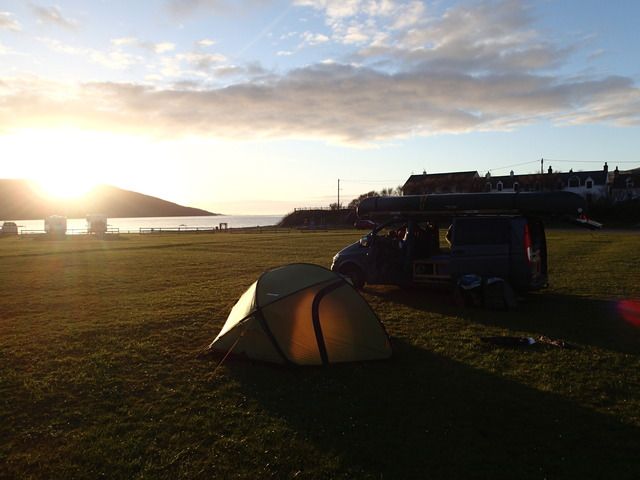
After lighting a small fire in the barbecue, we sat around and had a few drinks. When it got fully dark, I noticed an unusual dull glow in the northern sky, which developed into the first sighting of the aurora for both of us.

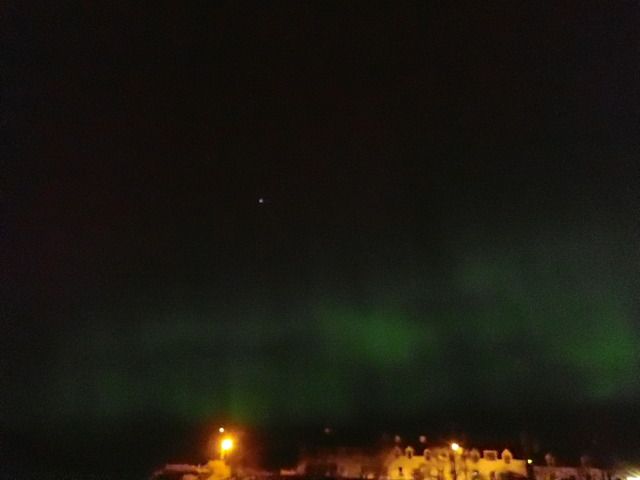
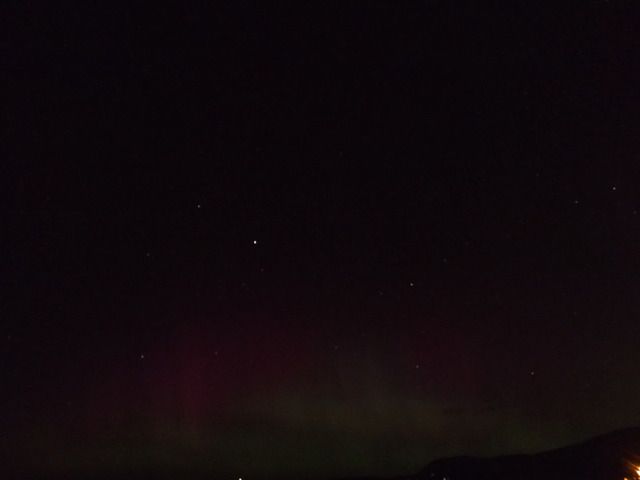
Before this started, wed planned to get our heads down for an early start, but after being taken to a better viewing spot by some locals, and getting back to the campsite and finishing the bottle of Glenmorangie, it was quite late, which resulted in a very relaxed start in the morning.
Day 2: Bog Camp.
We were on our way the next day at crack of noon, and drove up to Elphin through some spectacular countryside; if things were this good from the van, they must be amazing when you got away from the road.

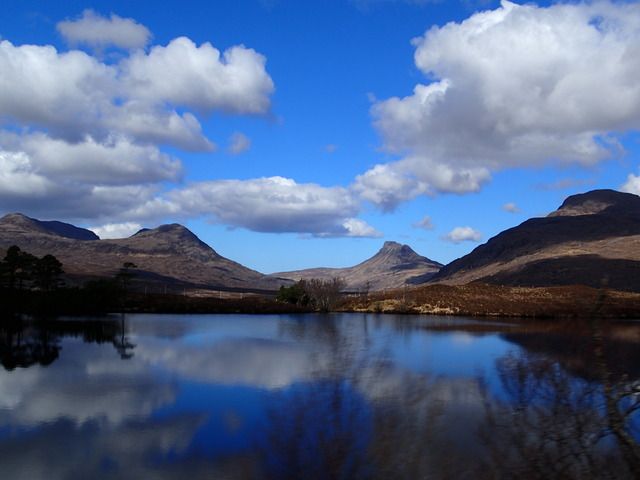
We decided to miss Cam Loch, and launch straight into Loch Veyatie. The people in the farm just opposite the gates to the abandoned fish farm said that it would be ok to drive down to the shores of Loch Veyatie, unload and then return to the road and park the van by the village hall.
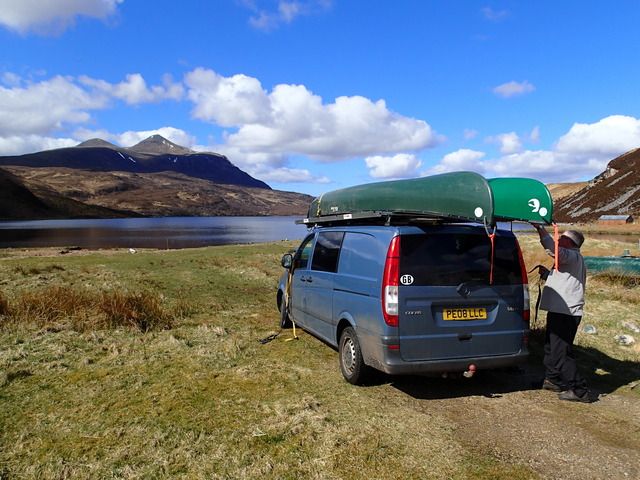
On this trip, I are been mostly wearin' wellies:
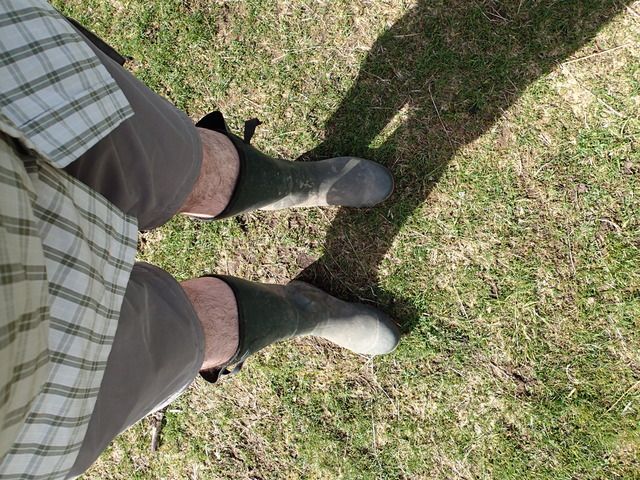
This done, we were soon on the water in really good conditions paddling towards Suilven in the distance.
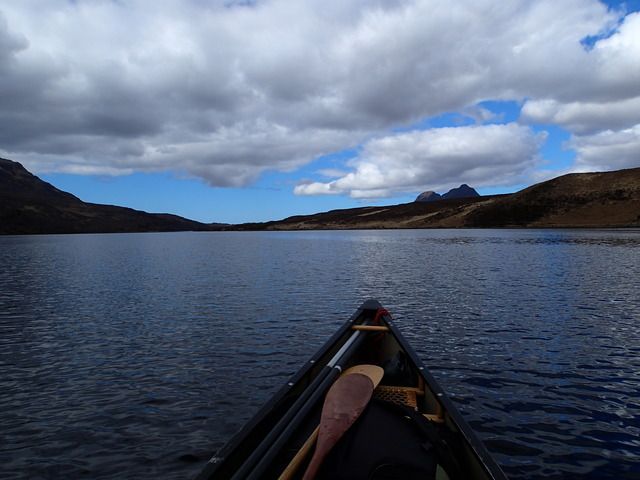
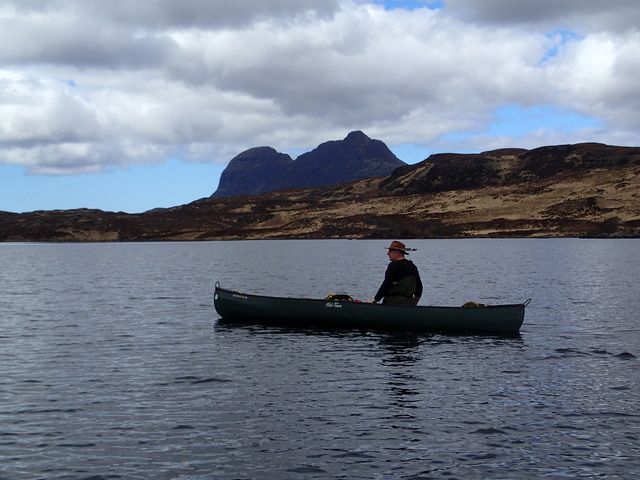
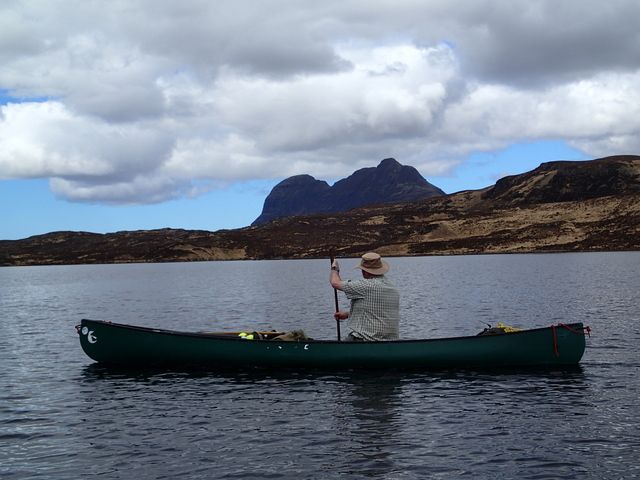
Before we reached the end of Loch Veyatie though, we passed through the sand bar into Loch a Mhadail, which turned out to be a perfectly still, steep sided glacial loch, with the best echoes that Ive ever heard.

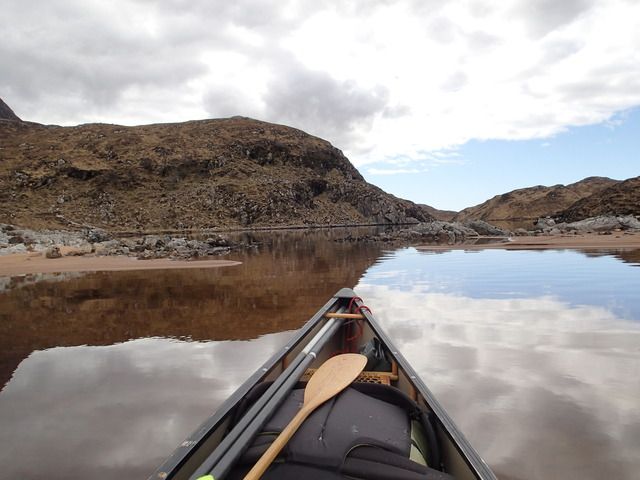
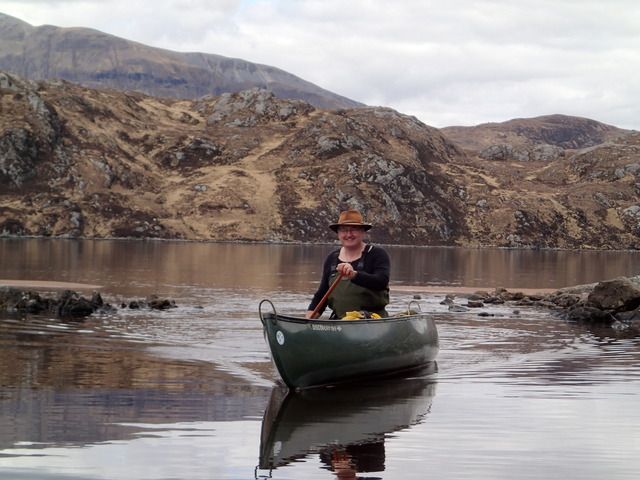

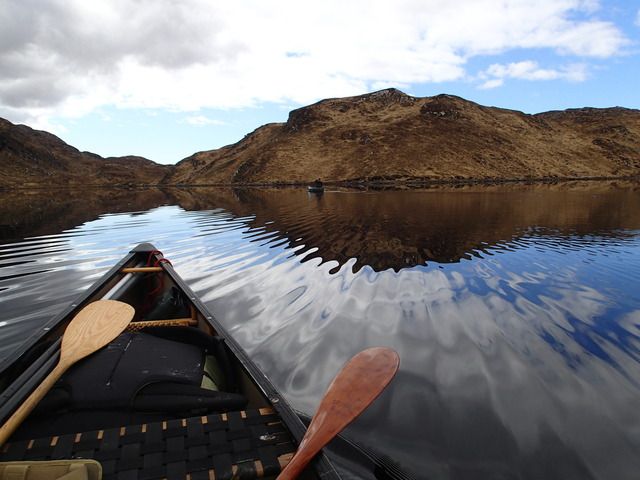
The effortless paddling soon came to an end however, as the south-western end of the loch was the start of our first, and most brutal portage.
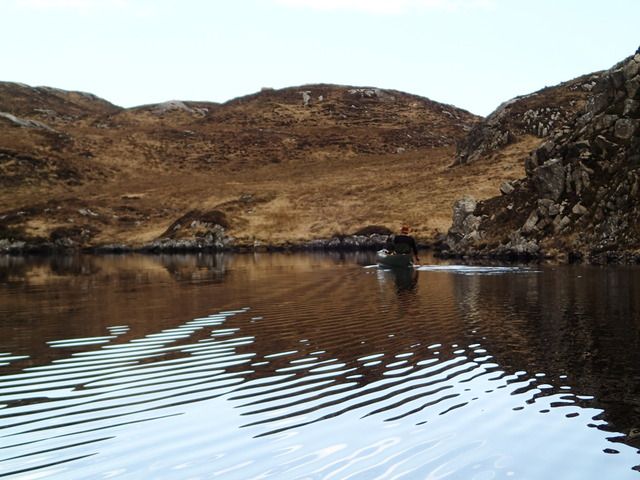
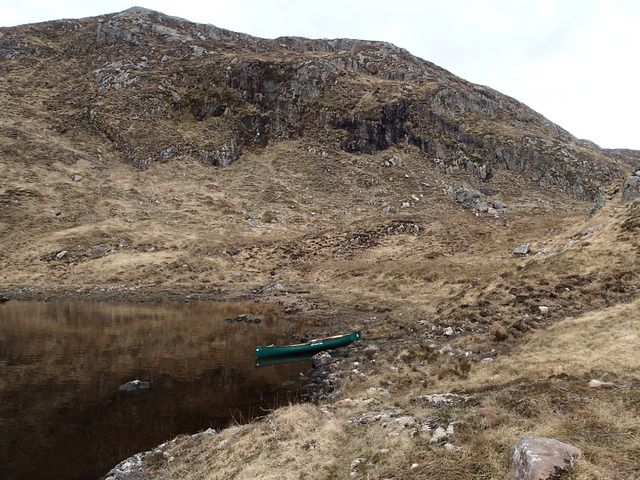
On the map, and on Google Earth, it didnt look too bad. A short but fairly steep pull out of Loch a Mhadail, across the height of land and then reasonably flat moorland with occasional drops down to Lochan na Claise.
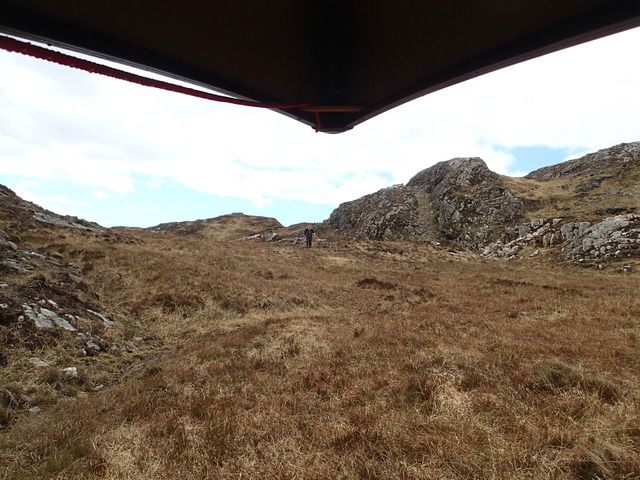
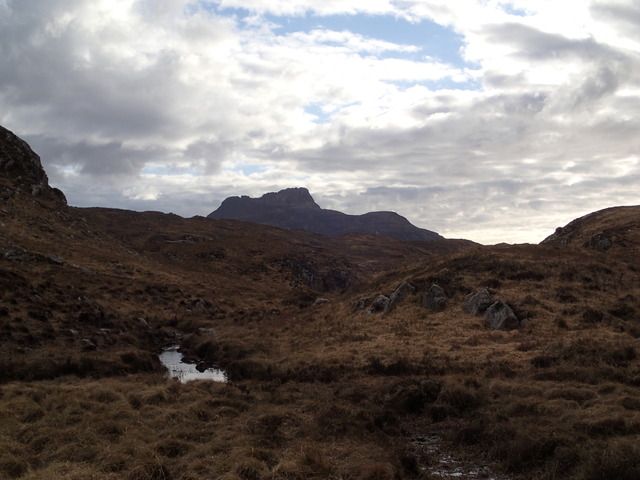
I even imagined that it might be possible to line the canoes partway down the burn, to save carrying or dragging them (*see below). We carried the canoes and packs up to the highpoint, stopped for a late lunch and imagined the hardest part behind us. How wrong we were. I crossed the height of land by carrying my packs and canoe (not all at once, I made three trips), and dumping them at the start of a long flat, rock free section where I planned to put the packs in the canoe start dragging. I noted with some disappointment that the stream was far too small and rocky to float even an unladen canoe, but I was optimistic that it would be bigger after the next drop. Before I started dragging though, I went back to help Steve who didnt have portage packs, so he had to make more trips, and to help him drag his canoe, which is a fair bit heavier than mine.
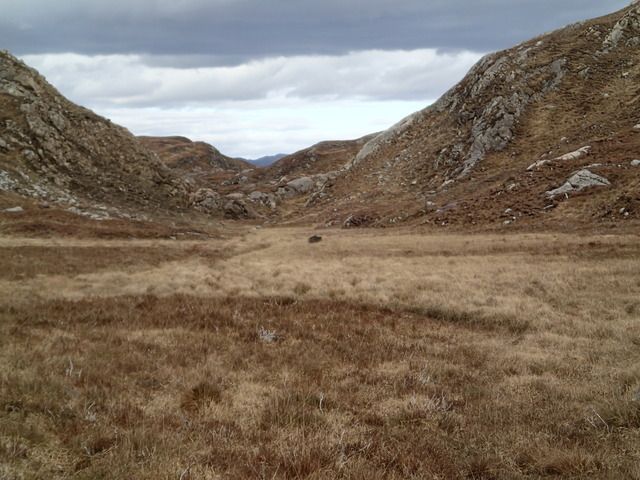
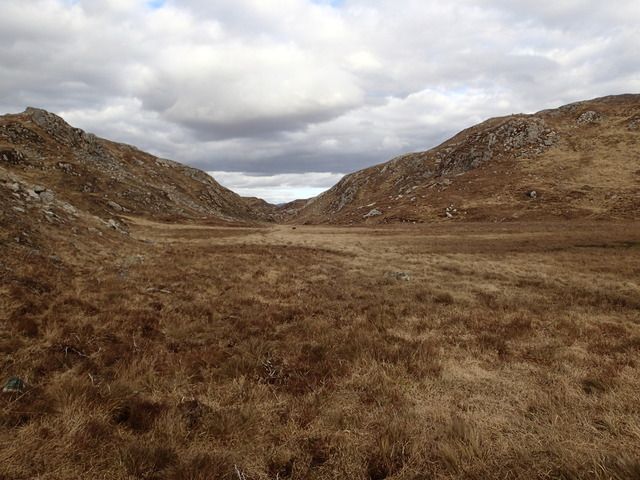
We marvelled at the ease with which we could drag Steves beaten up, 20 year old canoe, even with some of his gear in, doing a two man man-haul. We decided that this would be the way to go, and dragged and carried Steves outfit to where Id dumped mine. When it came to dragging my gear however, it became apparent that my Royalex Novacraft Cronje had a much higher friction hull than Steves Polylink Old Town 169. I accused Steve of buttering his hull, which he vigorously denied, although I did note that he ate dry bread for the rest of the trip. The difference was so marked that it seemed to take about the same effort to drag my empty canoe as it took to drag Steves with a load in it.
Michael and Steve manhauling along the Glen of Doom (citation needed):
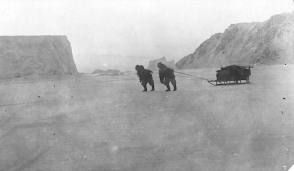
Looking down the glen, I was quite perturbed that there was no sign of Lochan na Claise, or Loch Sionasgaig, our destination for that day. I had thought that Id be able to see one or either of them in the distance, but not to worry, on with the portage. It was around this time that we realised that in this part of Inverpolly, there are only three elements; water, rock and bog. Wed left the water behind, we had to carry the canoes over any rock, and although we could drag the canoes over the bog, it seemed consist of high friction heather and high friction grass on the surface, with varying depths of mud or peat underneath. The manhauling was made more strenuous by the unseasonably warm weather, which perversely enough, was the reason that I had changed my plans and gone to Inverpolly in the first place.
We dragged and carried, dragged and carried etc. our way along the glen, sweating and cursing and stopping occasionally for a rest or to filter some water. I havent drank as much water since I worked in the middle east, and while the burn wasnt deep enough to float a canoe in, it did provide refreshment. To add to the desolate feel of this part of the trip, the only wildlife we saw were some insolent ravens and a few frogs.
Here's one of the blighters:
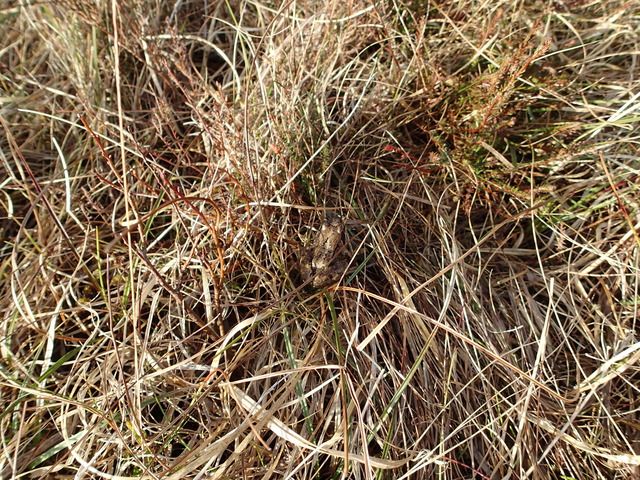
On one of the drops, we finally got a glimpse of Lochan na Claise in the distance, and dishearteningly, it was much further away that we thought it would be. We carried on though, dragging and carrying, until we came to the ruins of Clais, with the lochan in plain view. We were now within about 300m of open water, and the burn still wasnt deep enough to float a canoe. It wouldnt be until we were about *100m away from Lochan na Claise, when it was an absolute delight to throw the packs into the canoes and line them down to the lochan.
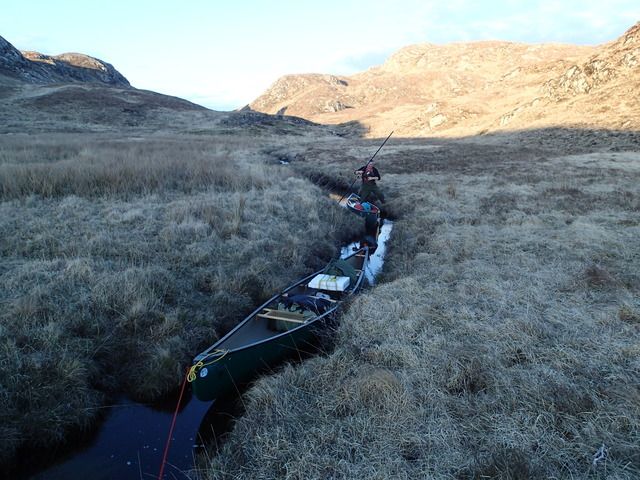
It was getting late now, so we hurried across Lochan na Claise to the short portage into Loch Sionasgaig. It had taken us 5 ½ hours (including lunch) to travel about a mile.
Despite the beauty of the clear evening, we couldnt hang about, and paddled to Eilean Mor (Big Island) to find somewhere to camp.
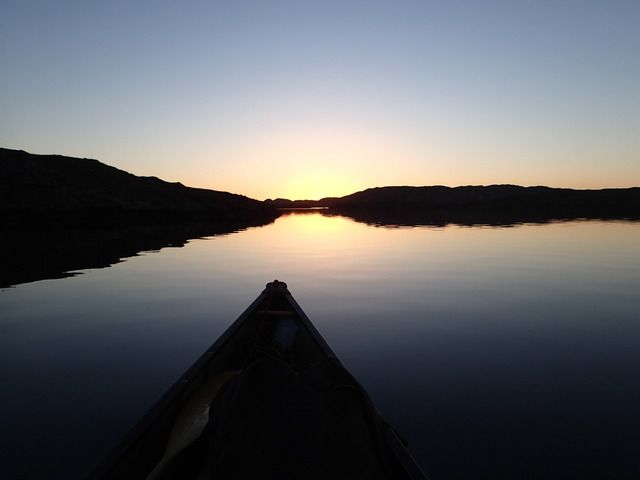
In the almost-darkness, we struggled to find a campsite that didnt consist of an uncomfortable mixture of the three Inverpolly elements. In the end, we found a piece of bog that was slightly less moist than the bog that surrounded it, and set up camp.
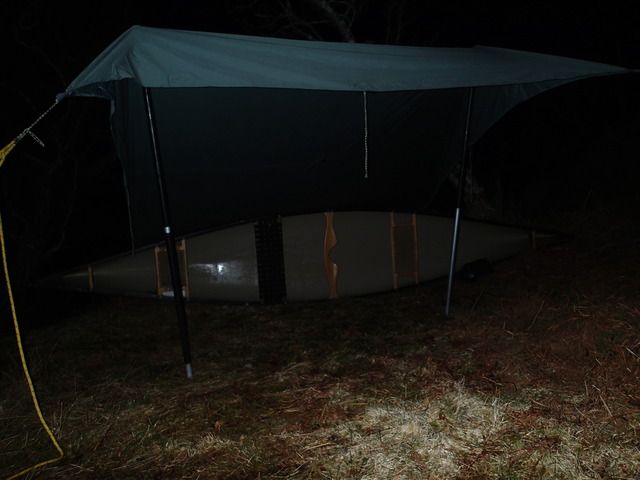
We obviously werent the first people to resort to camping here, as there was small fire ring with some logs that had been kindly left by the previous inhabitants, which we were very thankful for.
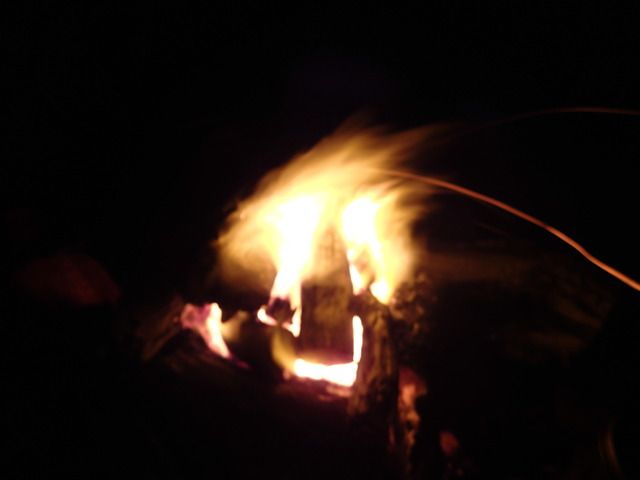
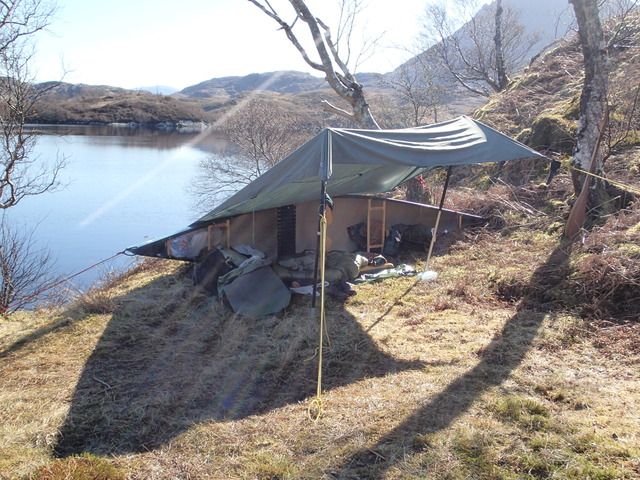
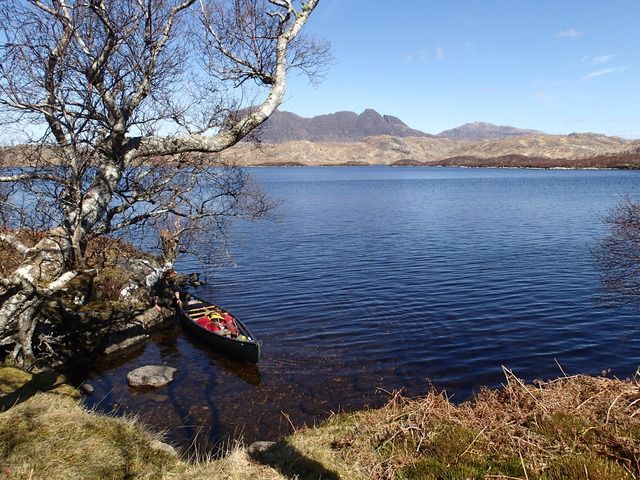
Day 3: Dry Ground Camp.
After a surprisingly good nights sleep at Bog Camp, we left Eilean Mor at mid-morning. Having not learned our lesson from the previous day, we paddled to the northern end of Loch Sionasgaig to the start of the portage to Loch a Ghille.
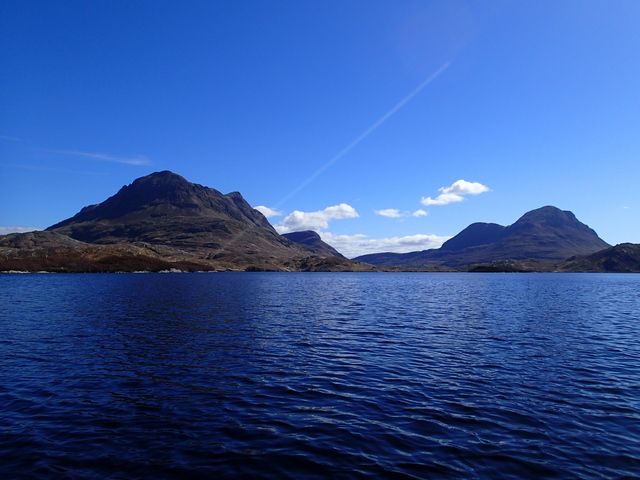
Despite being almost all uphill, this portage was much shorter than yesterdays ordeal, and didnt seem very hard. We also saw lots of lizards darting about as we carried and dragged our kit.
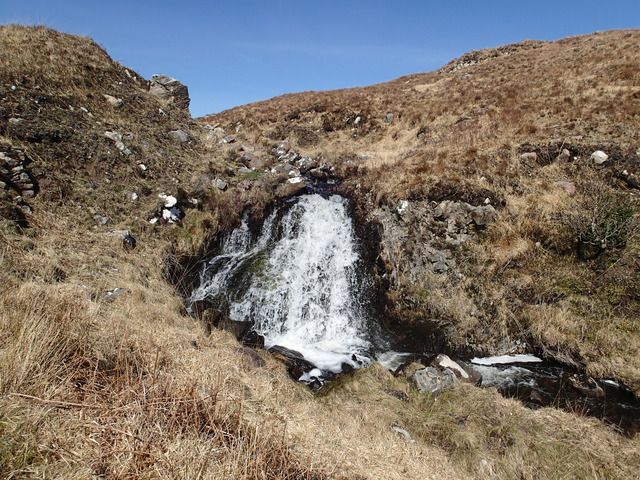
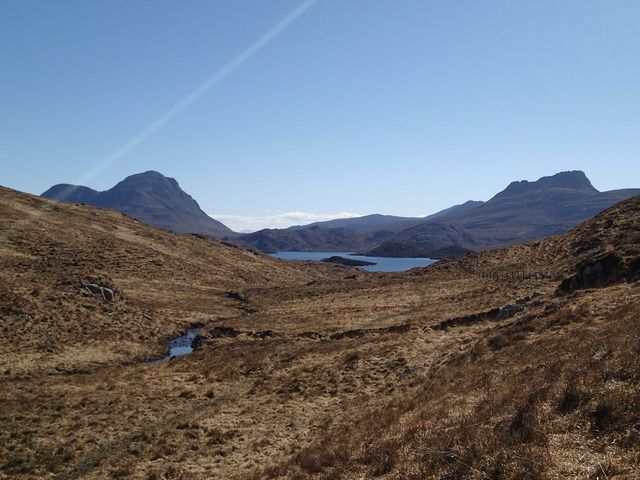
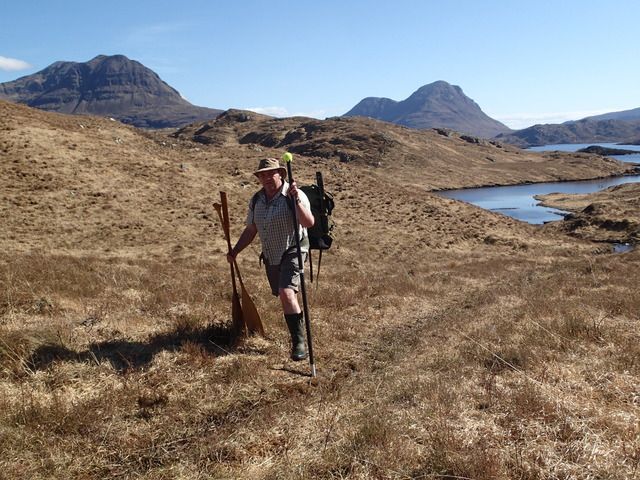

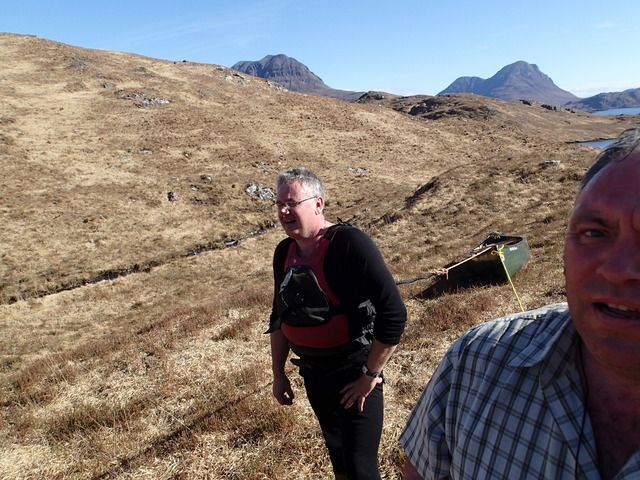
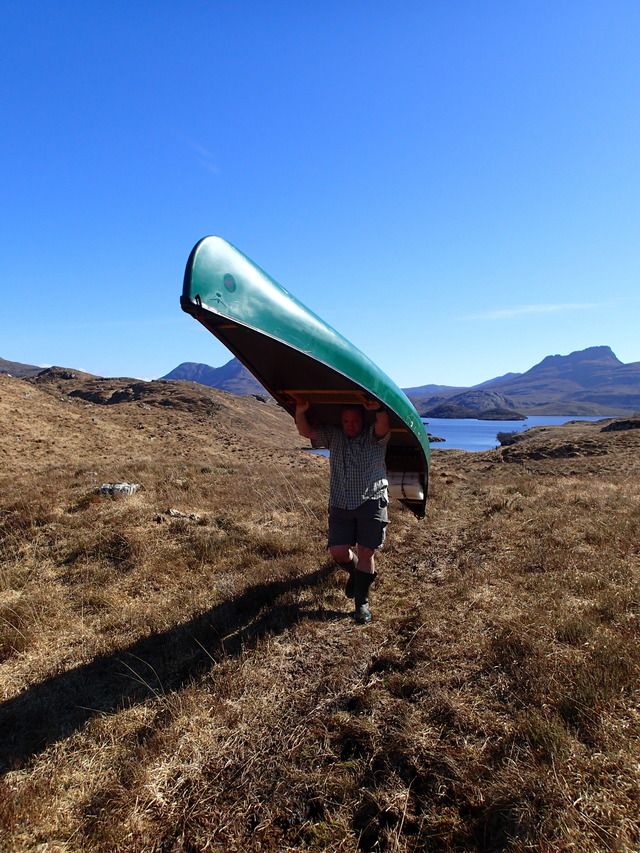
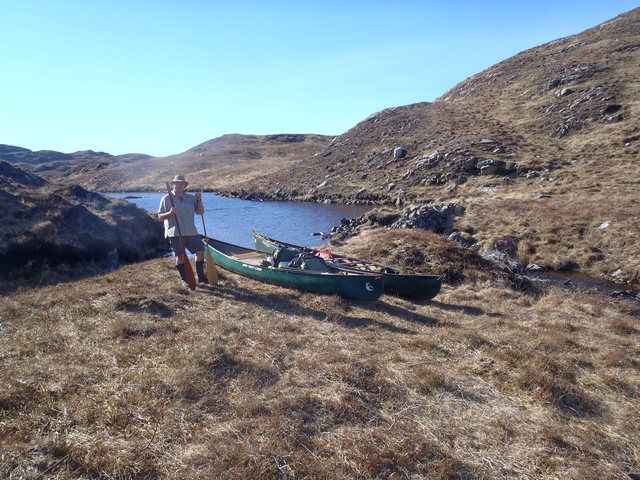
Loch a Ghille is a lovely stretch of water, and we savoured the pleasant paddling and sightings of red deer as we headed towards the next portage.
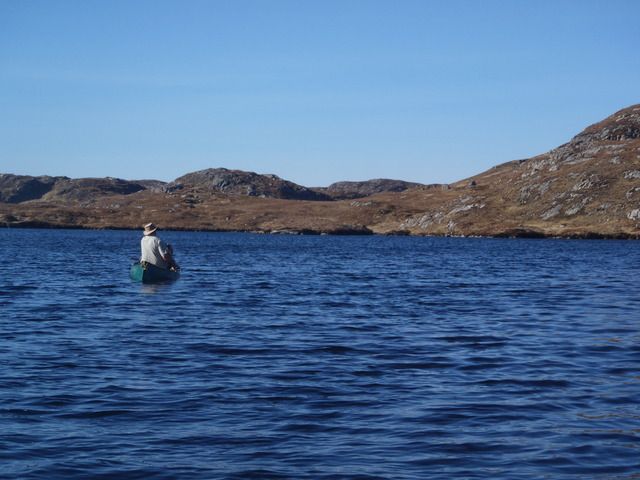

We beached the canoes at the start of this, and walked half the portage to scout it out for the next day.
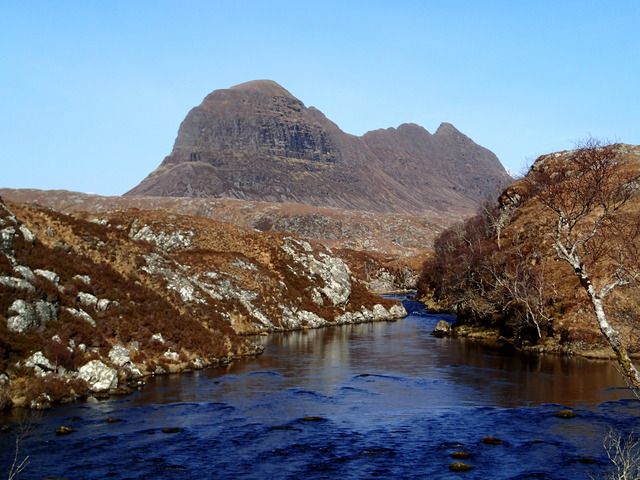
It seemed alright, so we returned to the canoes and split up to find a decent campsite on the shores of Loch a Ghille, and get settled earlier than the previous night. Steve found a piece of dry ground about 6m long by 2m wide, and amazed by the lack of moisture in it, we set up camp for what turned out to be quite a windy night.
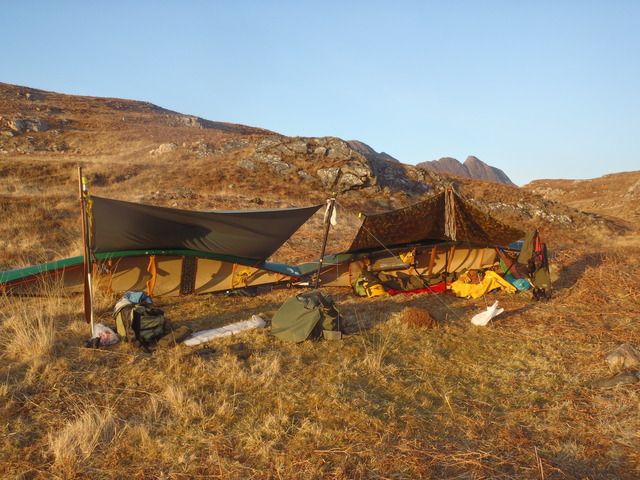
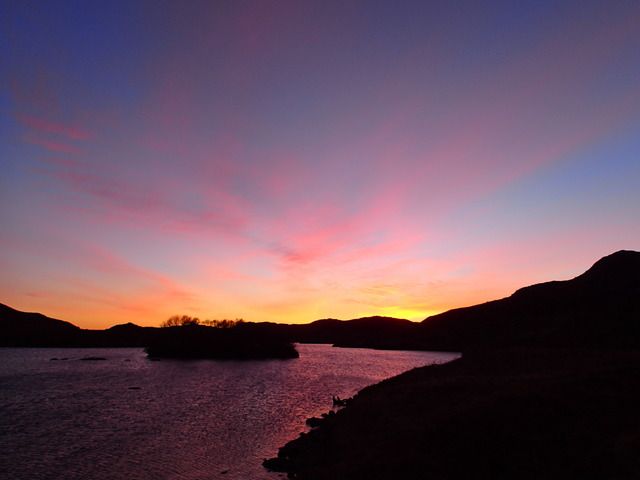

I cooked my dinner on my little alcohol stove using an onion and mushrooms that Steve gave to me (I was starting to discover why his packs were so heavy) and an obscene amount of butter in my pasta in sauce.

Steve said that I looked like an oversized Ghengis Khan in my fur cap, or at least thats how I interpreted it when he said that I looked like a fat Mongol in my trapper hat.
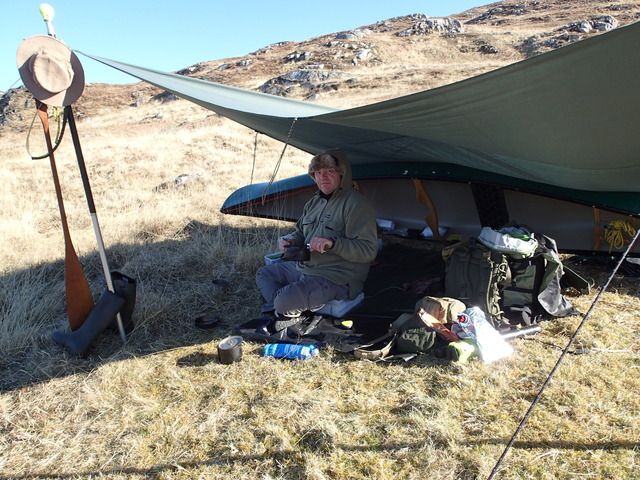
Wed found some wood earlier in the day, and this provided us with a fire to drink our whisky around.
Day 4: Desolation Camp.
After breaking camp, we paddled the short distance to the start of the portage and started to move our stuff to the halfway point, where we had to cross a fence.
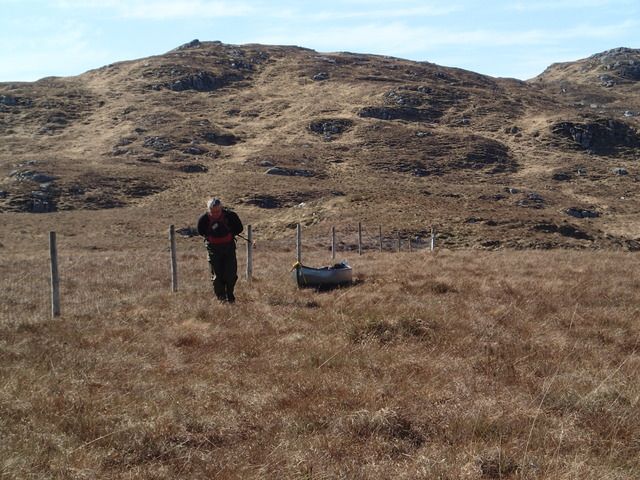

When all the gear was there, we stopped and had lunch before tackling the final stretch, which consisted of the boggiest bog so far, followed by quite a steep uphill section before a very steep downhill that ended at the River Kirkaig, where we would be able to float the canoes again.
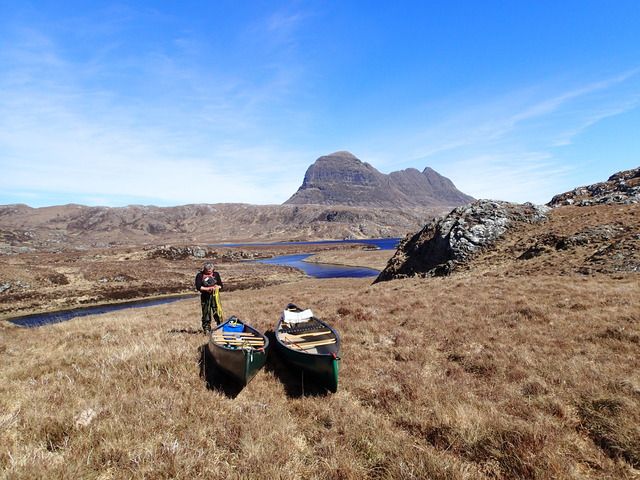
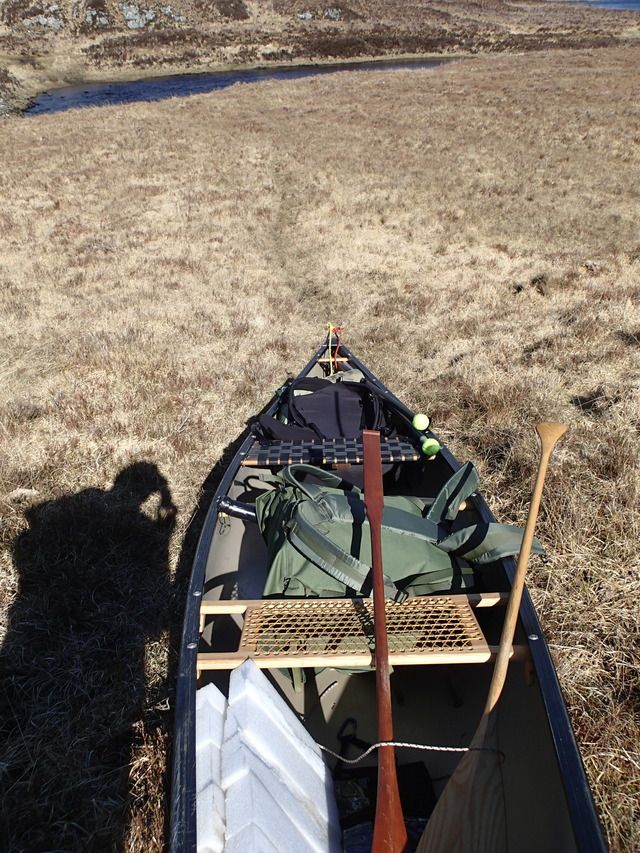
The River Kirkaig is the outlet from Fionn Loch, and we had to track the canoes upstream for a couple of hundred metres as the flow gets fast very soon after leaving the loch before turning into a rapid.

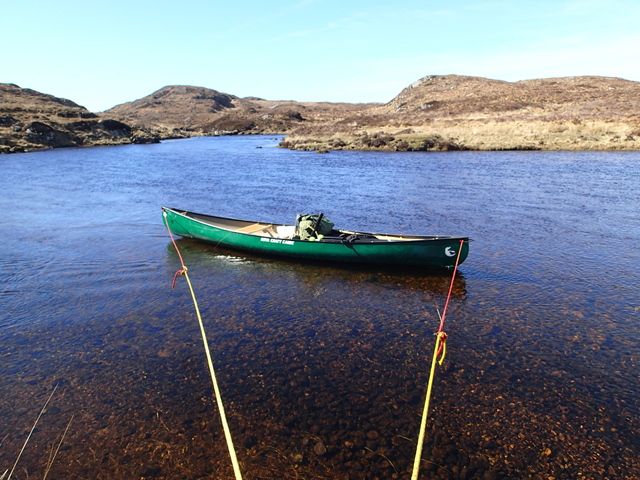
As soon as it became slow enough to paddle against, we jumped into the canoes and paddled for the narrows that separate the river and loch.

Prior to passing through the narrows, we had been sheltered from the wind, the full force of which soon became apparent. It was very difficult to paddle against it, and whitecaps were starting to break on the waves.

There was a shingle beach on the opposite side of the loch which was the only likely campsite that we could see, but we didnt want to cross the loch broadside to the wind. We pulled into shelter behind a headland and consulted the map, which showed a narrowing of the loch further on, where we would be able to turn around and cross the loch with the wind on our rear left quarter. After short but tough paddle against the wind, we turned and surfed across the loch with the wind at our backs.

As it was still quite early, we decided to wait a bit and see if the wind dropped, which would enable us to paddle further up Fionn Loch and find a better campsite. The shingle beach we were on was not as big as it had looked from the other side, and was quite steep. The crag on the eastern side of it didnt give much shelter from the wind, and apart from a few dried heather stalks, there wasnt any firewood to be had. As the afternoon turned into evening though, the wind increased, and some ominous looking clouds gathered in the east.
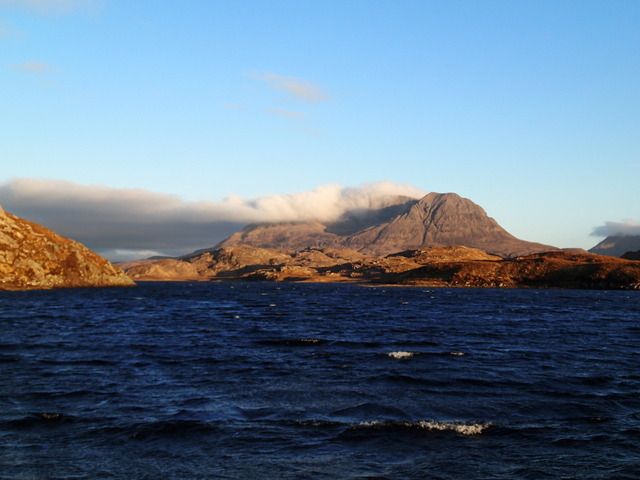
We decided to make the best of things and get established on the beach before any weather hit.
There was a knackered old wire fence strewn over the beach with metal fence posts, which I broke up to make half metre long stakes to hold our tarps down. I battered these into the shingle with a rock, and they seemed really secure.
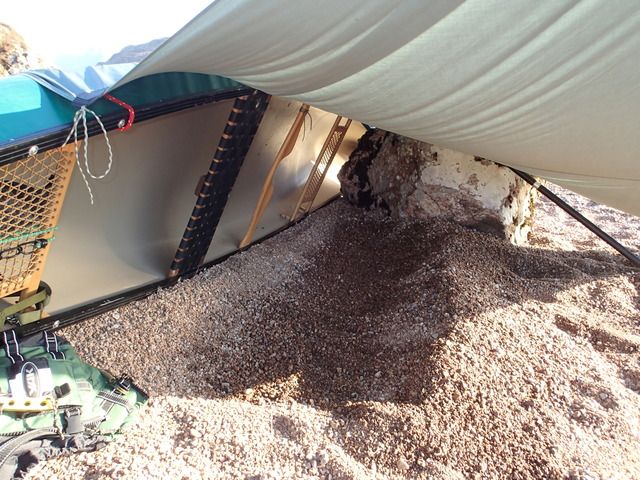
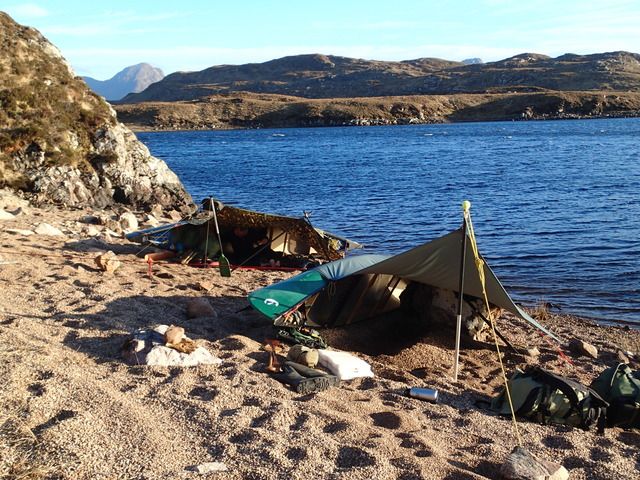
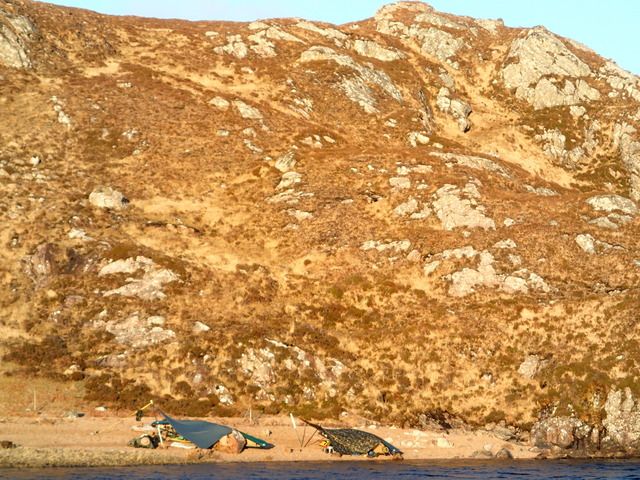

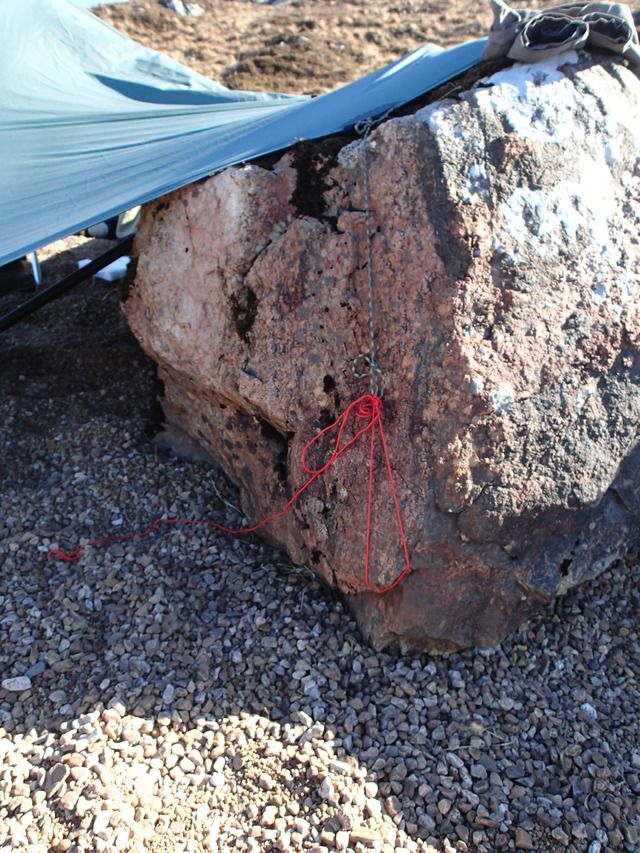
As the wind increased later on, we backed these up with big rocks. Both of our tarps were set up to shed the wind, and I dug a bed shaped depression in the shingle. Once we got set up and out of the wind, it turned into a very pleasant evening. The wind continued to increase, but the cloud in the east didnt follow it and the weather stayed dry. I used my alcohol stove again to cook dinner, more Pasta in Sauce, washed down with several mugs of red wine.
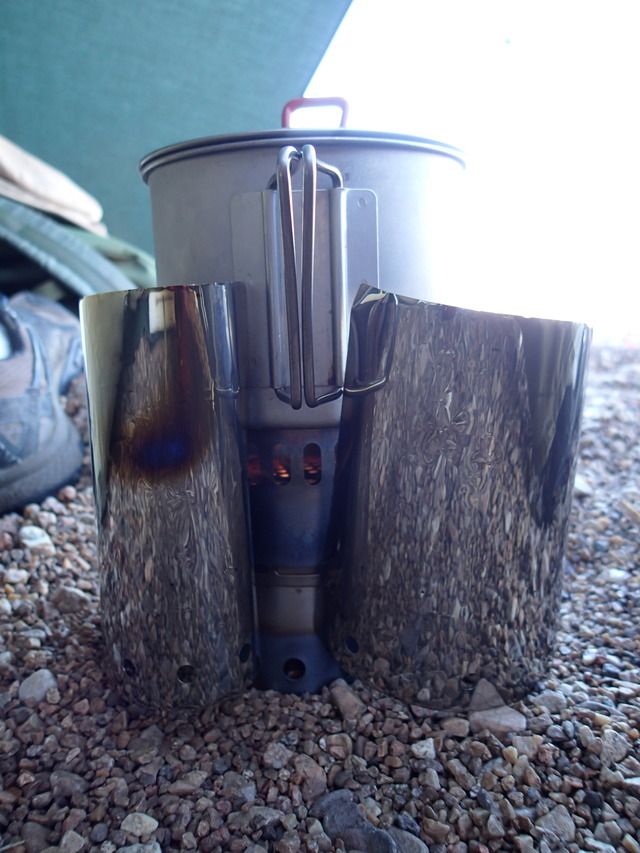
I watched the sun go down and then had a fairly early and surprisingly comfortable night.
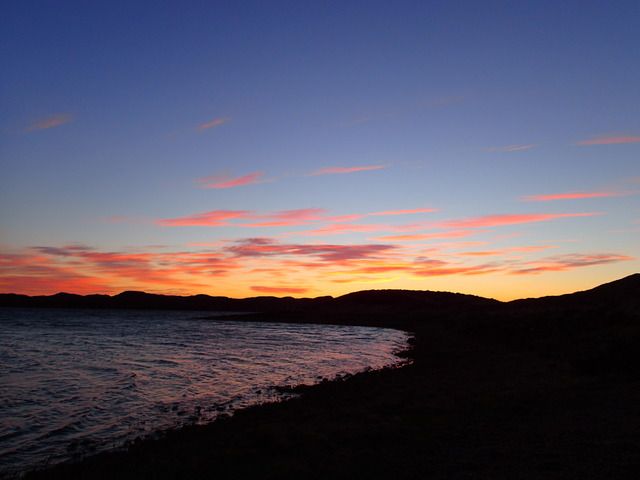

The next morning was still windy, but it was decreasing as the morning went on. By the time wed had breakfast and packed up, the wind had dropped to almost nothing, and as we paddled up Fionn Loch and started to pole, wade and track our way up Uidh Fhearna (the short river that links Fionn Loch and Loch Veyatie) it had dropped completely. Travelling upstream was very straightforward, but I could have done with longer tracking lines in places.
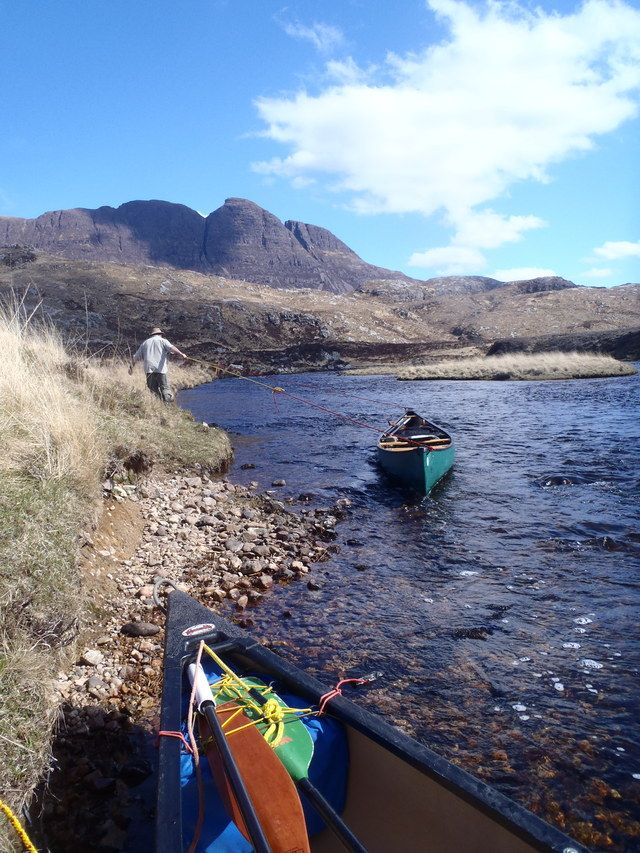


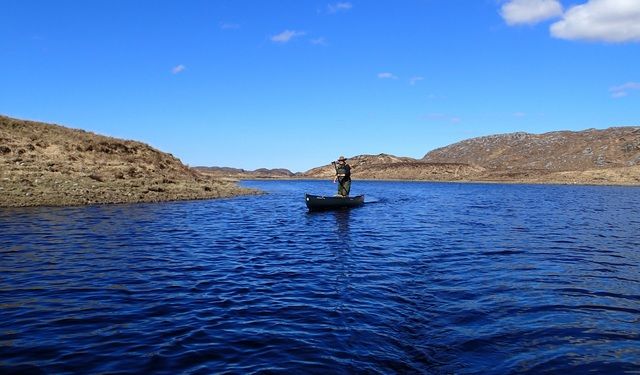

We stopped for lunch as we entered Loch Veyatie, and as we finished eating, the wind picked up again to the strength of the previous night. Fortunately it had turned 180° and was now at our backs, so we had a very swift paddle / surf up the loch to our starting point at the fish farm. Id left my sail in the van to save weight, and at times I wished that Id brought it, but Im not sure if my Heath Robinson mast mount would have coped with that strength of wind.

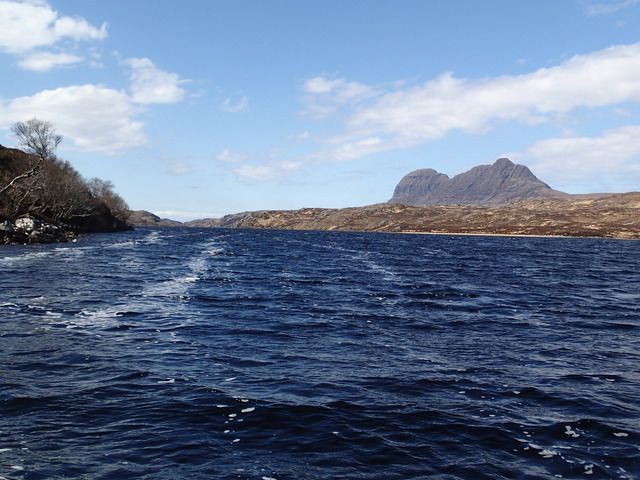
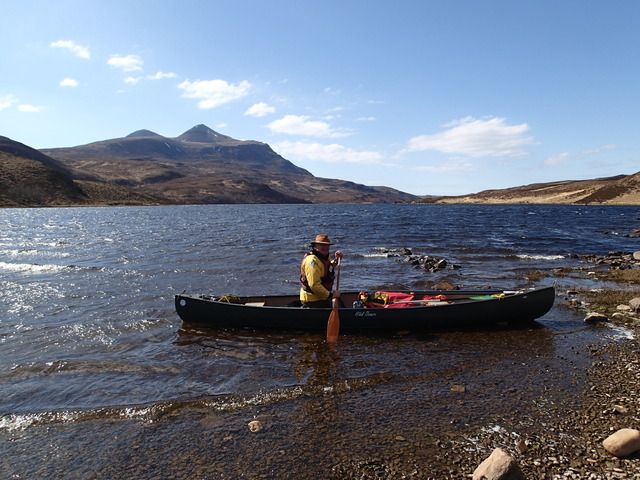
That was the end of a fantastic trip, and I want to return to Inverpolly in the future. I had wanted to walk over Suilven while I was there, but my legs werent up to it after hauling the packs and dragging the canoes across the portages. The next time I come Ill ascend Suilven before doing any portaging. I also wont be doing the portage from Loch a Mhadail to Loch Sionasgaig again. We did it in the downhill direction and it was bad enough, so those who do it the other way around are in for a bit of an ordeal.
The highlights of the trip for me were the views over Loch Sionasgaig from the top of the portage to Loch a Ghille, and paddling on and camping beside Loch a Ghille. Apart from all of this, just being able to see Suilven is good for the soul, and we saw it a lot. As well as this, just being in this remote area, surrounded by iconic mountains and paddling on lochs that you cant get to without a bit of effort was brilliant.
We left Cumbria on Thursday afternoon, hoping to get to Inverpolly in time to launch on to Cam Loch and find somewhere to camp. As it was, we pulled in to Ullapool with the sun going down, and decided to camp there. Had we known how long the twilight lasts this far north, we would have continued to Cam Loch, but our decision proved to have its compensations.
I pitched my tent and Steve sorted his van out for sleeping in, and then we had a very nice curry within 100 metres of the campsite.

After lighting a small fire in the barbecue, we sat around and had a few drinks. When it got fully dark, I noticed an unusual dull glow in the northern sky, which developed into the first sighting of the aurora for both of us.



Before this started, wed planned to get our heads down for an early start, but after being taken to a better viewing spot by some locals, and getting back to the campsite and finishing the bottle of Glenmorangie, it was quite late, which resulted in a very relaxed start in the morning.
Day 2: Bog Camp.
We were on our way the next day at crack of noon, and drove up to Elphin through some spectacular countryside; if things were this good from the van, they must be amazing when you got away from the road.


We decided to miss Cam Loch, and launch straight into Loch Veyatie. The people in the farm just opposite the gates to the abandoned fish farm said that it would be ok to drive down to the shores of Loch Veyatie, unload and then return to the road and park the van by the village hall.

On this trip, I are been mostly wearin' wellies:

This done, we were soon on the water in really good conditions paddling towards Suilven in the distance.



Before we reached the end of Loch Veyatie though, we passed through the sand bar into Loch a Mhadail, which turned out to be a perfectly still, steep sided glacial loch, with the best echoes that Ive ever heard.





The effortless paddling soon came to an end however, as the south-western end of the loch was the start of our first, and most brutal portage.


On the map, and on Google Earth, it didnt look too bad. A short but fairly steep pull out of Loch a Mhadail, across the height of land and then reasonably flat moorland with occasional drops down to Lochan na Claise.


I even imagined that it might be possible to line the canoes partway down the burn, to save carrying or dragging them (*see below). We carried the canoes and packs up to the highpoint, stopped for a late lunch and imagined the hardest part behind us. How wrong we were. I crossed the height of land by carrying my packs and canoe (not all at once, I made three trips), and dumping them at the start of a long flat, rock free section where I planned to put the packs in the canoe start dragging. I noted with some disappointment that the stream was far too small and rocky to float even an unladen canoe, but I was optimistic that it would be bigger after the next drop. Before I started dragging though, I went back to help Steve who didnt have portage packs, so he had to make more trips, and to help him drag his canoe, which is a fair bit heavier than mine.


We marvelled at the ease with which we could drag Steves beaten up, 20 year old canoe, even with some of his gear in, doing a two man man-haul. We decided that this would be the way to go, and dragged and carried Steves outfit to where Id dumped mine. When it came to dragging my gear however, it became apparent that my Royalex Novacraft Cronje had a much higher friction hull than Steves Polylink Old Town 169. I accused Steve of buttering his hull, which he vigorously denied, although I did note that he ate dry bread for the rest of the trip. The difference was so marked that it seemed to take about the same effort to drag my empty canoe as it took to drag Steves with a load in it.
Michael and Steve manhauling along the Glen of Doom (citation needed):

Looking down the glen, I was quite perturbed that there was no sign of Lochan na Claise, or Loch Sionasgaig, our destination for that day. I had thought that Id be able to see one or either of them in the distance, but not to worry, on with the portage. It was around this time that we realised that in this part of Inverpolly, there are only three elements; water, rock and bog. Wed left the water behind, we had to carry the canoes over any rock, and although we could drag the canoes over the bog, it seemed consist of high friction heather and high friction grass on the surface, with varying depths of mud or peat underneath. The manhauling was made more strenuous by the unseasonably warm weather, which perversely enough, was the reason that I had changed my plans and gone to Inverpolly in the first place.
We dragged and carried, dragged and carried etc. our way along the glen, sweating and cursing and stopping occasionally for a rest or to filter some water. I havent drank as much water since I worked in the middle east, and while the burn wasnt deep enough to float a canoe in, it did provide refreshment. To add to the desolate feel of this part of the trip, the only wildlife we saw were some insolent ravens and a few frogs.
Here's one of the blighters:

On one of the drops, we finally got a glimpse of Lochan na Claise in the distance, and dishearteningly, it was much further away that we thought it would be. We carried on though, dragging and carrying, until we came to the ruins of Clais, with the lochan in plain view. We were now within about 300m of open water, and the burn still wasnt deep enough to float a canoe. It wouldnt be until we were about *100m away from Lochan na Claise, when it was an absolute delight to throw the packs into the canoes and line them down to the lochan.

It was getting late now, so we hurried across Lochan na Claise to the short portage into Loch Sionasgaig. It had taken us 5 ½ hours (including lunch) to travel about a mile.
Despite the beauty of the clear evening, we couldnt hang about, and paddled to Eilean Mor (Big Island) to find somewhere to camp.

In the almost-darkness, we struggled to find a campsite that didnt consist of an uncomfortable mixture of the three Inverpolly elements. In the end, we found a piece of bog that was slightly less moist than the bog that surrounded it, and set up camp.

We obviously werent the first people to resort to camping here, as there was small fire ring with some logs that had been kindly left by the previous inhabitants, which we were very thankful for.



Day 3: Dry Ground Camp.
After a surprisingly good nights sleep at Bog Camp, we left Eilean Mor at mid-morning. Having not learned our lesson from the previous day, we paddled to the northern end of Loch Sionasgaig to the start of the portage to Loch a Ghille.

Despite being almost all uphill, this portage was much shorter than yesterdays ordeal, and didnt seem very hard. We also saw lots of lizards darting about as we carried and dragged our kit.







Loch a Ghille is a lovely stretch of water, and we savoured the pleasant paddling and sightings of red deer as we headed towards the next portage.


We beached the canoes at the start of this, and walked half the portage to scout it out for the next day.

It seemed alright, so we returned to the canoes and split up to find a decent campsite on the shores of Loch a Ghille, and get settled earlier than the previous night. Steve found a piece of dry ground about 6m long by 2m wide, and amazed by the lack of moisture in it, we set up camp for what turned out to be quite a windy night.



I cooked my dinner on my little alcohol stove using an onion and mushrooms that Steve gave to me (I was starting to discover why his packs were so heavy) and an obscene amount of butter in my pasta in sauce.

Steve said that I looked like an oversized Ghengis Khan in my fur cap, or at least thats how I interpreted it when he said that I looked like a fat Mongol in my trapper hat.

Wed found some wood earlier in the day, and this provided us with a fire to drink our whisky around.
Day 4: Desolation Camp.
After breaking camp, we paddled the short distance to the start of the portage and started to move our stuff to the halfway point, where we had to cross a fence.


When all the gear was there, we stopped and had lunch before tackling the final stretch, which consisted of the boggiest bog so far, followed by quite a steep uphill section before a very steep downhill that ended at the River Kirkaig, where we would be able to float the canoes again.


The River Kirkaig is the outlet from Fionn Loch, and we had to track the canoes upstream for a couple of hundred metres as the flow gets fast very soon after leaving the loch before turning into a rapid.


As soon as it became slow enough to paddle against, we jumped into the canoes and paddled for the narrows that separate the river and loch.

Prior to passing through the narrows, we had been sheltered from the wind, the full force of which soon became apparent. It was very difficult to paddle against it, and whitecaps were starting to break on the waves.

There was a shingle beach on the opposite side of the loch which was the only likely campsite that we could see, but we didnt want to cross the loch broadside to the wind. We pulled into shelter behind a headland and consulted the map, which showed a narrowing of the loch further on, where we would be able to turn around and cross the loch with the wind on our rear left quarter. After short but tough paddle against the wind, we turned and surfed across the loch with the wind at our backs.

As it was still quite early, we decided to wait a bit and see if the wind dropped, which would enable us to paddle further up Fionn Loch and find a better campsite. The shingle beach we were on was not as big as it had looked from the other side, and was quite steep. The crag on the eastern side of it didnt give much shelter from the wind, and apart from a few dried heather stalks, there wasnt any firewood to be had. As the afternoon turned into evening though, the wind increased, and some ominous looking clouds gathered in the east.

We decided to make the best of things and get established on the beach before any weather hit.
There was a knackered old wire fence strewn over the beach with metal fence posts, which I broke up to make half metre long stakes to hold our tarps down. I battered these into the shingle with a rock, and they seemed really secure.





As the wind increased later on, we backed these up with big rocks. Both of our tarps were set up to shed the wind, and I dug a bed shaped depression in the shingle. Once we got set up and out of the wind, it turned into a very pleasant evening. The wind continued to increase, but the cloud in the east didnt follow it and the weather stayed dry. I used my alcohol stove again to cook dinner, more Pasta in Sauce, washed down with several mugs of red wine.

I watched the sun go down and then had a fairly early and surprisingly comfortable night.


The next morning was still windy, but it was decreasing as the morning went on. By the time wed had breakfast and packed up, the wind had dropped to almost nothing, and as we paddled up Fionn Loch and started to pole, wade and track our way up Uidh Fhearna (the short river that links Fionn Loch and Loch Veyatie) it had dropped completely. Travelling upstream was very straightforward, but I could have done with longer tracking lines in places.





We stopped for lunch as we entered Loch Veyatie, and as we finished eating, the wind picked up again to the strength of the previous night. Fortunately it had turned 180° and was now at our backs, so we had a very swift paddle / surf up the loch to our starting point at the fish farm. Id left my sail in the van to save weight, and at times I wished that Id brought it, but Im not sure if my Heath Robinson mast mount would have coped with that strength of wind.



That was the end of a fantastic trip, and I want to return to Inverpolly in the future. I had wanted to walk over Suilven while I was there, but my legs werent up to it after hauling the packs and dragging the canoes across the portages. The next time I come Ill ascend Suilven before doing any portaging. I also wont be doing the portage from Loch a Mhadail to Loch Sionasgaig again. We did it in the downhill direction and it was bad enough, so those who do it the other way around are in for a bit of an ordeal.
The highlights of the trip for me were the views over Loch Sionasgaig from the top of the portage to Loch a Ghille, and paddling on and camping beside Loch a Ghille. Apart from all of this, just being able to see Suilven is good for the soul, and we saw it a lot. As well as this, just being in this remote area, surrounded by iconic mountains and paddling on lochs that you cant get to without a bit of effort was brilliant.

